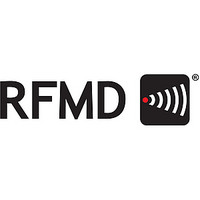RF2958 RF Micro Devices, RF2958 Datasheet - Page 11

RF2958
Manufacturer Part Number
RF2958
Description
2.4GHz SPREAD-SPECTRUM TRANSCEIVER
Manufacturer
RF Micro Devices
Datasheet
1.RF2958.pdf
(20 pages)
Available stocks
Company
Part Number
Manufacturer
Quantity
Price
Part Number:
RF2958
Manufacturer:
RFMD
Quantity:
20 000
Company:
Part Number:
RF2958SR
Manufacturer:
RFMD
Quantity:
15 500
Company:
Part Number:
RF2958TR13
Manufacturer:
ICS
Quantity:
60
Part Number:
RF2958TR13
Manufacturer:
RFMD
Quantity:
20 000
RF2958
IF/Baseband
The filtered IF signal is processed through a variable gain amplifier controlled through the RX VGC pin. The IF signal is
then downconverted to baseband I and Q signals, which are then filtered on-chip with third order Bessel filters. The
IF-to-baseband conversion gain range is 4dB to 72dB depending on the voltage present on the RX VGC pin. The gain
slope is negative over a range of 1.2V to 2.0V.
The single-ended I and Q outputs should be DC-coupled to the baseband processor. The DC reference voltage should
be provided to the baseband processor through the VREF pin to eliminate the potential for a signal blocker at DC.
TRANSMITTER
The I and Q inputs are differential. To use single-ended inputs, place 0.01µF capacitors at the I BYP and Q BYP pins.
The inputs should be DC-coupled from the baseband processor. In order to improve carrier suppression at RF, the DC
reference voltage should be provided to the baseband processor through the VREF pin. The baseband input signals are
filtered on-chip using third order Bessel filters for spectral shaping. The signals are then complex upconverted to IF. The
IF mixer output is amplified and connected to the IF OUT pins as a differential signal for connecting to the external SAW
filter as described above.
The differential signal from the SAW filter is then amplified using a variable gain amplifier. The gain of this amplifier can
be controlled either through the analog TX VGC pin or digitally from the baseband processor or MAC, depending on
application. The signal is then upconverted to the desired RF output frequency and amplified to a level appropriate to
drive a PA to the desired output level at the antenna.
In order to further extend battery life, the TX VGC pin can be used to control the bias of the external PA. If the user of the
end-product determines that he/she does not require full output power, the PA bias and the gain of the IF variable gain
amplifier can be controlled by the RF2958 to reduce the current consumption of the PA, thereby increasing battery life.
Contact RFMD Applications Engineering for guidance on implementing this feature.
DUAL FREQUENCY SYNTHESIZER
IF LO PLL
The IF PLL is an integer-N PLL nominally programmed to a center frequency of 748MHz. This frequency is divided by
two at the IF converter. A 44MHz oscillator is required to provide the PLL reference frequency through the MCLK pin.
See the Register Details and Serial Data Interface sections for details on programming.
RF LO PLL
www.DataSheet4U.com
The RF LO PLL is a fractional-N PLL programmed to an appropriate frequency to convert the 374MHz IF to the desired
24
RF channel. The nominal step size is 22MHz with a fractional modulus of 2
. The 44MHz reference frequency is divided
to the appropriate step size. See the Register Details and Serial Data Interface sections for details on programming.
Note: To ensure proper operation of the PLLs, program Register 12 [17:16] to ‘11b’. All other bits in Register 12 should
be set to ‘0’.
Rev A0 050209
11-273












